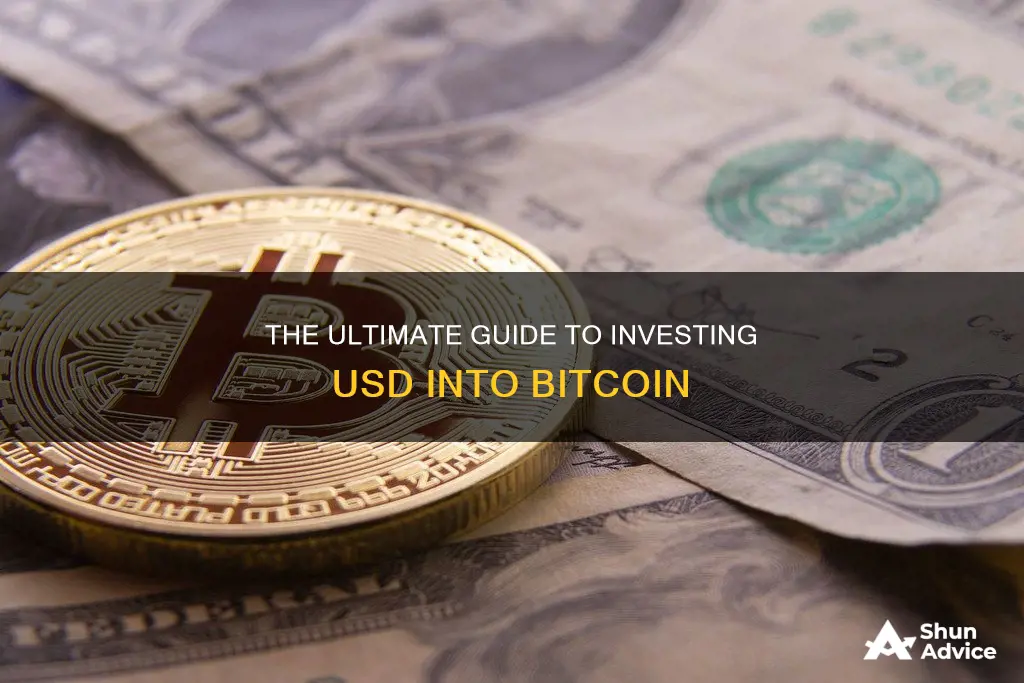
Investing in Bitcoin can be a daunting task for beginners, but it's not as complicated as it seems. Here's a step-by-step guide to help you get started:
Step 1: Choose a Crypto Exchange or Platform
Select a reputable and secure cryptocurrency exchange or platform, such as Coinbase, Binance, or Kraken. These platforms offer a variety of cryptocurrencies, including Bitcoin. Compare the fees, security measures, and payment options before making your choice.
Step 2: Create an Account and Verify Your Identity
Sign up for an account on your chosen platform. You will likely need to provide personal information and verify your identity with a government-issued ID. This step is crucial for security and regulatory compliance.
Step 3: Fund Your Account
Before you can buy Bitcoin, you need to deposit funds into your account. You can typically use various payment methods, such as bank transfers, credit cards, or debit cards. Each method may have different processing fees and transfer times, so choose the one that suits you best.
Step 4: Place Your First Bitcoin Order
Once your account is funded, you can place your first Bitcoin order. Decide how much USD you want to invest, keeping in mind that you don't need to purchase a whole Bitcoin. You can invest as little as $25 or even less on some exchanges.
Step 5: Store Your Bitcoin in a Wallet
After purchasing Bitcoin, you'll need a secure place to store it. You can choose between a hot wallet, which is an online wallet provided by the exchange or a third-party provider, or a cold wallet, which is an offline storage device like a USB drive. Cold wallets are generally considered more secure but may be less convenient for frequent trading.
Remember, investing in Bitcoin and other cryptocurrencies carries significant risks. The market is highly volatile, and prices can fluctuate wildly. Always do your research, understand the risks involved, and invest only what you can afford to lose.
| Characteristics | Values |
|---|---|
| How to buy Bitcoin | Through a crypto exchange, traditional stockbrokers, money transfer apps, Bitcoin ATMs, or Bitcoin ETFs. |
| Crypto exchange options | Gemini, Kraken, Coinbase, Crypto.com, GDAX, BitStamp |
| Traditional stockbroker options | Robinhood, Webull, TradeStation, Fidelity |
| Money transfer app options | PayPal, Venmo, Cash App |
| Bitcoin wallet options | Hot wallet, cold wallet |
| Hot wallet description | Transactions are generally faster; stored by a trusted exchange or provider in the cloud and accessed through an app or computer browser on the internet |
| Cold wallet description | Considered much more secure than hot wallets; a small, encrypted portable device that allows you to download and carry your Bitcoin |
| Other things to consider | Two-factor authentication, strong passwords, and secure internet connections |
What You'll Learn

Choose a crypto-trading service or venue
Choosing a crypto-trading service or venue is the first step to investing in Bitcoin. There are several options available, each with its own pros and cons. Here are some factors to consider when selecting a crypto-trading service or venue:
Cryptocurrency Exchanges:
Cryptocurrency exchanges are a popular option for buying and selling Bitcoin. Examples include Coinbase, Kraken, Gemini, and Binance, which offer a wide range of features and cryptocurrencies for trading. When choosing an exchange, consider factors such as security, fees, the number of supported cryptocurrencies, and customer service. It is also important to use two-factor authentication and a strong password for added security.
Traditional Stockbrokers:
Traditional stockbrokers like Robinhood, Webull, TradeStation, and Fidelity also offer access to Bitcoin trading. Robinhood, for example, charges no fees for Bitcoin trades. However, the choices among traditional brokers that offer crypto trading are limited.
Peer-to-Peer Money Transfer Apps:
Cash transfer services like PayPal, Venmo, or Cash App allow users to purchase, store, send, and sell Bitcoin directly through their apps. This option may be convenient for those already familiar with these interfaces. However, it is important to note that purchasing crypto through PayPal may restrict the ability to transfer crypto to other accounts or wallets.
Bitcoin ATMs:
Bitcoin ATMs are another option for buying and selling Bitcoin. These machines are often placed in locations similar to traditional ATMs, such as convenience stores. It is important to consider the fees associated with using Bitcoin ATMs, which can be relatively high compared to other options.
Bitcoin Exchange-Traded Funds (ETFs):
The recent approval of spot Bitcoin ETFs by the Securities and Exchange Commission has made it easier for traditional investors to gain access to Bitcoin. These ETFs track the price of Bitcoin and can be traded over major exchanges through traditional brokerage accounts.
When choosing a crypto-trading service or venue, it is important to consider factors such as security, fees, ease of use, and the range of features and cryptocurrencies offered. It is also crucial to understand the risks associated with investing in Bitcoin and other cryptocurrencies, as the market is highly volatile.
Why You Should Avoid a Bitcoin IRA
You may want to see also

Connect your exchange to a payment option
To start investing in Bitcoin, you will need to create an account with a cryptocurrency exchange. These exchanges allow users to buy, sell, and hold cryptocurrencies. Once you have chosen an exchange, you will need to link your account to a payment source, such as a debit card or bank account. This step is crucial, as it will enable you to fund your account and eventually purchase Bitcoin.
Each exchange offers different payment methods, so it is essential to select one that aligns with your preferences and needs. Most exchanges support wire transfers, while some also allow the use of credit or debit cards for added convenience. It is worth noting that fees may vary depending on the chosen payment method, with higher fees associated with credit card transactions due to processing fees and the risk of fraud.
When connecting your exchange to a payment option, you will typically be required to provide personal identification information. This may include submitting a copy of your driver's license or Social Security card, as well as details about your employment and source of funds. The verification process helps ensure the security and legitimacy of transactions on the exchange.
It is important to carefully review the fees, deposit and withdrawal limits, fund settlement times, and security track record of the exchange before proceeding. Additionally, not all exchanges support the direct purchase of Bitcoin with fiat currencies, so be sure to select an exchange that offers this option if you intend to buy Bitcoin with USD.
By following these steps and connecting your exchange to a suitable payment option, you will be well on your way to investing in Bitcoin. Remember to always do your research, understand the risks involved, and only invest what you can afford to lose.
A Beginner's Guide to Investing in Bitcoin (in Australia)
You may want to see also

Place an order
Once you've chosen a crypto-trading service or venue, the next step is to place an order.
After you've set up an account with your chosen exchange, you'll need to fund your account before you can start investing in Bitcoin. Check if your exchange has a Bitcoin wallet built into its platform. If not, you'll need to find one of your own. Once your account is funded and you have a wallet, you can place your first order to buy Bitcoin.
Depending on the platform you're using, you may be able to purchase Bitcoin by tapping a button, or you may have to enter Bitcoin's ticker symbol: BTC. Next, input the amount you want to invest. If Bitcoin's current price is around $40,000, you'd need to invest that much to buy 1 BTC. If you invested less, say $1,000 when 1 BTC equals $40,000, you'd get a percentage of a Bitcoin equal to about 0.025 BTC.
Cryptocurrency exchanges have evolved and now offer several order types and ways to invest. Almost all crypto exchanges offer both market and limit orders, and some also provide stop-loss orders. For example, Kraken offers market, limit, stop-loss, stop-limit, take-profit, and take-profit limit orders. Exchanges also offer ways to set up recurring investments, allowing clients to dollar-cost average into their investments of choice. For example, Coinbase lets users set recurring purchases for every day, week, or month.
Bitcoin Derivatives: A Guide to Investing and Trading
You may want to see also

Store your Bitcoin in a hot or cold wallet
Once you've bought Bitcoin, you'll need to store it in a digital wallet. There are two main types of wallets: hot wallets and cold wallets.
Hot wallets are always connected to the internet, usually in the form of an app on a device such as a computer, phone, or tablet. They are used to temporarily store and send/receive cryptocurrency. They are convenient for small amounts of cryptocurrency or cryptocurrency that is actively being traded or spent. However, because they are connected to the internet, they are more vulnerable to hacks and theft. Examples of hot wallets include MetaMask, Coinbase Wallet, and Edge Wallet.
Cold wallets, on the other hand, are offline devices that are not connected to the internet. They are considered to be much more secure than hot wallets as they are not susceptible to online attacks. Cold wallets are ideal for storing large amounts of cryptocurrency or for long-term holding. Examples of cold wallets include hardware wallets (e.g. Ledger Nano X, Trezor Model T), paper wallets (where your private and public keys are printed on a piece of paper), and sound wallets (where your private keys are stored as audio files).
While hot wallets are generally free, cold wallets typically cost around $50 to $200. It's important to note that some hot wallet providers may also offer cold wallet services. For example, Coinbase provides a hot wallet for its customers to interact with its exchange services, but it also offers a hardware wallet called Coinbase Wallet.
When choosing between a hot wallet and a cold wallet, it's important to consider your needs and priorities. If you prioritise convenience and speed of transactions, a hot wallet may be more suitable. On the other hand, if security and peace of mind are your top priorities, a cold wallet is likely the better option. Ultimately, many people use a combination of both types of wallets to balance accessibility and security.
The Ultimate Guide to Investing in Litecoin Cash
You may want to see also

Understand the risks
Investing in Bitcoin comes with a number of risks that you should be aware of. Here are some of the key risks to consider:
Volatile and Fluctuating Market
The price of Bitcoin is highly volatile and constantly fluctuating. This makes it difficult to predict whether you will get a return on your investment. To minimise the risk of massive losses, it is recommended to make small investments and keep a close eye on the market.
Cyberattacks and Fraud
Bitcoin and other cryptocurrencies are technology-based, which makes them vulnerable to cyberattacks and fraud. Hacking is a serious risk, as there is often no way to retrieve lost or stolen Bitcoins. Additionally, there have been reports of buyers losing their investments on exchanges and through mining losses. Exchanges are particularly susceptible to hacking, even if you have the protection of a smart wallet. It is important to carefully research and choose a reliable cryptocurrency wallet to minimise this risk.
Lack of Regulation
The Bitcoin market currently operates with little to no major regulations, as it is a relatively new concept. The lack of taxation and government stance on cryptocurrency can be enticing for investors, but it also creates uncertainty and potential future problems. There is no guarantee that companies or governments will widely accept Bitcoin in the future, which could impact its value.
Technology Reliance
Bitcoin is entirely reliant on technology, as it is an online exchange. Without the underlying technology, Bitcoin and other cryptocurrencies become worthless. This also makes Bitcoin owners more vulnerable to cyber threats and online fraud. Unlike traditional forms of currency or investment, there is no physical collateral backing up Bitcoin.
Block Withholding
Bitcoin is created through solving mathematical equations called "blocks". However, a mining pool can use computational power to mine a block and hide it from honest miners, allowing a select few to benefit while others lose out. This practice can impact the availability of Bitcoin and affect the market.
Ponzi Scheme Concerns
Some critics have referred to Bitcoin as a Ponzi scheme, where people at the top benefit from the ignorance of others. As more people invest in Bitcoin, it creates a bubble economy that can burst, leaving many people holding worthless cryptocurrency with no return on their investment.
Schwab's Guide to Buying Bitcoin
You may want to see also
Frequently asked questions
The first step is to choose a crypto-trading service or venue, such as a cryptocurrency exchange, and connect it to a payment option.
You can store your Bitcoin in a "hot wallet" or a "cold wallet". A hot wallet is accessible via the internet and is generally more convenient, but less secure. A cold wallet is a physical storage device, like a USB, that keeps your cryptocurrency keys completely offline and is more secure.
Experts generally agree that cryptocurrencies shouldn't make up more than 5% of your portfolio. It's important to never invest more than you can afford to lose.







